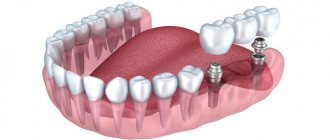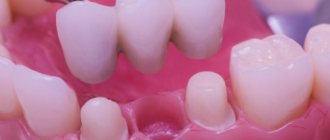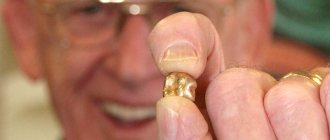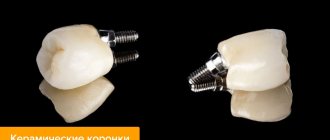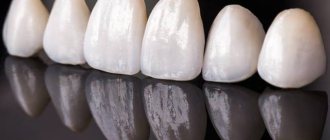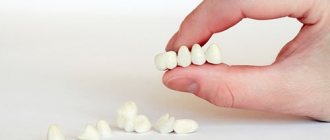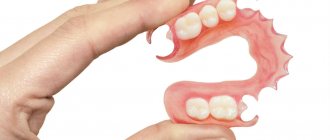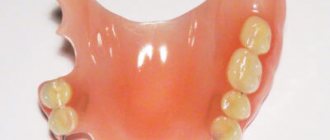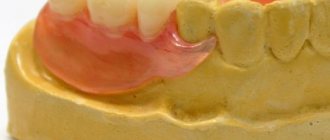Various materials can be used for prosthetics and dental restoration in modern dentistry, and one of the most popular types is ceramics or dental porcelain. This type of material is highly valued by professionals for its increased strength and aesthetics and the ability to create various types of orthopedic structures from it. Ceramics can be successfully used for the production of veneers, inlays, dental bridges, and all-ceramic dental crowns.
We will talk in detail about what an all-ceramic dental crown is in the following sections of the article. After reading the material, you will become familiar with the design of an all-ceramic crown, its features, and indications for prosthetics with this type of structure.
All-ceramic dental crown: features
All-ceramic dental crowns are also called metal-free, because metals and their alloys are not used in the manufacture of this type of prosthesis. For this reason, installation of an all-metal crown on teeth is indicated primarily for people who have an individual allergic reaction to different types of metals.
Until recently, all-ceramic crowns were used exclusively for the restoration of anterior teeth. This was due to the insufficient strength of dental porcelain, which was previously used in the prosthetic procedure. But thanks to the emergence of innovative technologies in dentistry, it has become possible to use all-ceramic crowns to restore any lost tooth in the oral cavity: modern ceramics are characterized by increased strength and reliability. Moreover, heavy-duty removable and bridge-type prostheses are produced from ceramics.
The price of an all-ceramic crown will be higher than prices for other types of structures, but at the same time it is fully justified by its excellent performance characteristics.
Stages and features of prosthetics
Prosthetics has many features and difficulties, which is why it must be carried out by a qualified orthopedic dentist. Before making and installing crowns, the doctor will diagnose the oral cavity. He will carefully examine your mouth for periodontitis, inflammation, periodontal disease or caries. Only after diagnosis will the dentist conclude whether all-ceramic prosthetics can be performed.
Installation of ceramic dentures is carried out in several stages:
- Professional cleaning of the oral cavity (it reduces the risk of complications and improves the quality of treatment).
- Elimination of caries.
- Depulpation of the tooth (if necessary).
- Removing the enamel layer from the supporting teeth.
- Taking an impression.
A layer of enamel is removed to the thickness that will be the crown.
The impression taken is sent to the laboratory for the production of all-ceramic orthopedic structures. The time it takes for the prosthesis to be ready depends on the production technology.
While the prosthesis is being made, the dentist will place temporary crowns that will protect the teeth from damage and help maintain an aesthetic appearance.
Orthopedic structures made of ceramics are made using CAD/CAM technology (computer modeling) or manually. The first option is more expensive, but the result is the most anatomical and high-quality crowns that cannot be distinguished from real teeth.
After the orthopedic design is made, the client is invited to try it on. If he does not feel discomfort or pain, then the prosthesis is attached to the teeth using an adhesive composition.
Ceramic orthopedic structures require careful special care. You need to brush your teeth 2 times a day with a regular brush with soft bristles or an irrigator. Toothpaste with a minimal amount of abrasives is suitable for cleaning. After each meal, you should rinse your mouth with medicine or water. In addition, you need to visit the dentist at least 2 times a year for a preventive examination and treatment (if necessary).
Indications for the use of all-ceramic dental crowns in prosthetics
Prosthetics with all-ceramic crowns have a certain number of indications:
1. Metal-free structures are used for the restoration of one or several dental units located next to each other or at some distance.
2. Elimination of aesthetic defects in the area of the front teeth in rows.
3. The use of all-metal dental crowns is advisable if the patient has some pathologies of the natural enamel coating: increased abrasion, developmental anomalies, significant surface damage.
All-ceramic crowns will be the best option if the patient is allergic to metals and their alloys. You can get detailed advice on indications and contraindications for prosthetics with all-ceramic crowns from the specialists of our Vanstom clinic in Moscow! Prosthetics with all-ceramic crowns: technologies
Modern all-ceramic crowns have optimal functional characteristics: they are durable, reliable in use, and have transparency indicators identical to natural teeth. Externally, it is almost impossible to distinguish an all-ceramic crown from a natural tooth.
At the current time in dentistry, there are two main technologies for the production of all-ceramic crowns: manual and computerized. Let us consider in detail the nuances of each method of producing ceramic dentures.
All-ceramic crowns
from 19,700 rub. More about prices
We have been working since 1994
we are one of the first to open private dentistry in Moscow
Best materials
only new and modern equipment for dental treatment
Free
consultation with a dentist
Payment options
- cash
- plastic cards
- cashless payments
Doctors' experience
- with great experience
- graduated
- conference participants
Manual technology for the production of all-ceramic crowns
The production process of an all-ceramic crown using this method will be divided into several stages:
- Examination of the patient and taking dental impressions;
- Making a plaster model of the structure, which is carried out by a technician in a specialized laboratory;
- Modeling of a future all-ceramic dental crown;
- Fabrication of the frame and its cladding;
- Coating the finished structure with a layer of dental porcelain and grinding its surface to perfect smoothness.
It is important to note that the finishing layer on an all-ceramic crown can be created not only by layer-by-layer application, but also by coloring. It is advisable to use colored dentures for the restoration of chewing teeth, since in this case the fundamental characteristics of the design will be strength and durability. But in the restoration of the front rows of teeth, it is better to use all-ceramic crowns with a finish created in layers - they are impeccable in terms of aesthetics, which is so important for the smile area.
Computer technology for manufacturing all-ceramic crowns
This technology for creating all-ceramic dental crowns is the most modern; it uses specialized CAD/CAM equipment, with which a specialist can obtain an ultra-precise 3D image of the patient’s jaws. This makes it possible to create an all-ceramic prosthesis with optimal performance characteristics. Based on the computer model, an all-ceramic dental crown will be made in the future. Its production process consists of the following stages:
- Using a scanner, the specialist receives a computer model of the patient’s jaw, which speeds up the process of prosthetics as a whole. When using a virtual model, there is no need to waste time making a plaster cast;
- Next, also on a computer, the future all-ceramic crown is modeled;
- The finished crown model is transferred to a special machine on which the prosthesis is turned.
The process ends with the installation of an all-ceramic dental crown in the patient’s oral cavity. At this stage, final polishing of the prosthesis can also be performed to obtain maximum aesthetics of an all-ceramic crown.
In domestic aesthetic dentistry, the following technologies for computer-aided creation of all-ceramic crowns are popular: Katana, ZirconZahn, Cerec, Organical. Separately, it is worth mentioning the growing demand for prosthetics with all-ceramic emax crowns. Structures produced using this technology are distinguished by high strength, aesthetics, and high levels of biocompatibility with natural tissues of the human body. They do not require complex specific care and provide excellent results in prosthetics, 100% solving the problem of lost teeth.
You can find out more about the prosthetic service with all-ceramic emax crowns by making an appointment with a specialist at our Vanstom clinic in Moscow!
How do different ceramic crowns differ from each other?
One of the first articles for patients that once appeared on my blog was devoted to different types of crowns that are used in dental prosthetics. Today I will make a small addition dedicated to different types of the most aesthetic prosthetics - metal-free crowns . What are they? And how are they different? Let's get a look.
Today, dentists use 3 types of metal-free structures in prosthetics: crowns made of solid ceramics, frame crowns without ceramic lining, and, finally, frame crowns with ceramic lining.
Crowns made of solid ceramics.
Sometimes you can also hear their name in professional slang: “refractor” or “crowns/veneers on a refractor.”
Using this technology, crowns and veneers are made from solid ceramics. They are very thin and allow you to achieve the best results in terms of aesthetics. Such designs can be made on teeth even without grinding them or with very minimal grinding (0.2-0.4 mm). This is best suited for well-preserved anterior teeth and the most common indications are aesthetic, i.e. correction of the shape and color of a less than ideal natural tooth without serious damage.
A natural doubt arises about the strength of such weightless structures.
That's right, they are very thin and fragile, but... exactly until the moment they are glued to the tooth. Once the doctor has successfully and correctly glued such a crown or veneer to a tooth, they form a monolith that is quite difficult to destroy. Although theoretically, chips of the ceramic itself are still possible. But there are no special restrictions in using it for its intended purpose - everything that can be bitten with your own teeth can be bitten with such crowns. Opening bottles, chewing wire, husking seeds and similar violence against teeth does not apply here. It is advisable to avoid these activities, even if you have all your teeth like nothing else.
In terms of cost, this is usually the most expensive type of prosthetics, because very difficult to implement at all stages. It requires the doctor and dental technician to have mastery of their specialty, increased accuracy, longer work hours and more working hours.
Frame crowns without ceramic veneer.
These crowns are made from zirconia or lithium disilicate (a material better known under the brand name e.max ). These materials in their pure form have high strength, but reduced aesthetic characteristics. This makes it ideal to use these structures for prosthetics of lateral teeth. Here, impeccable aesthetics is often not as important as the durability of the material. After all, it is the lateral teeth that bear the maximum chewing load. An additional advantage of non-ceramic-veneered crowns is that they are virtually impossible to chip. Because The frame material itself is quite difficult to break off, and the much more fragile ceramic lining is missing.
As for aesthetics, on the side teeth it is quite possible to accept monochrome, lack of translucency and other aesthetic “issues” that bring the appearance of the artificial crown as close as possible to a natural tooth. Most often, designs made from solid zirconium dioxide or solid e.max are similar to plastic crowns - primarily due to their opacity and monochrome.
At the same time, it must be said that materials evolve almost every day. Already today, translucent zirconium dioxide has appeared in our practice, crowns made of which look almost “alive.” And with the proper skills of a dental technician, it is only possible to give them a completely aesthetic appearance through surface staining of solid structures, and you will not immediately understand which is an artificial tooth and which is a natural one.
As for the cost, the production of such structures in a dental laboratory has a simplified work cycle, involves less manual labor, and accordingly, this makes them less expensive.
Frame crowns with ceramic veneer.
This is a universal type of metal-free prosthetics. Such designs consist of a frame-cap (zirconium dioxide or e.max), onto which ceramic is applied on top in several layers. The result is a design that combines the properties of the two above groups. Suitable for both lateral and front teeth. Typically used in cases where the teeth already have significant loss of hard tissue.
In terms of cost, such structures usually occupy a middle position between the two previous groups.
In short, this is what modern types of dental prosthetics look like. I hope this now helps you navigate your decisions.
Advantages of using all-ceramic dental crowns in prosthetics
All-ceramic dental crowns compare favorably with analogs made from other materials due to the following advantages:
1. High aesthetics. The use of all-ceramic dental crowns allows you to obtain the most aesthetic appearance of the restored dental units. Ceramics has optimal transparency, which makes it outwardly indistinguishable from natural tooth enamel.
2. Installation of all-ceramic crowns is not capable of causing any negative or dangerous consequences for human health. Moreover, when using this type of prosthesis, tooth trauma will be minimal, since its installation does not require significant grinding of a healthy unit.
All-ceramic crowns are easy to use: they are light in weight, do not rub the soft tissues of the oral cavity, and do not create excessive stress on natural dental units. The advantages of all-metal structures definitely include their solid durability - a crown can last for more than ten years without loss of aesthetics and functionality. An all-ceramic crown does not require complex maintenance, but it must be regular, since the service life of the prosthesis and its preservation of all useful qualities depend on this.
Would you like to learn more about all-ceramic crowns and get high-quality prosthetic services at affordable prices! Come to our dentistry in Moscow - Vanstom!
Features of the prosthesis
Ceramics retains the ability to transmit light throughout its entire service life. This means that the installed bridge will look equally naturalistic both immediately after installation and after 3-5 years. The absence of metal inclusions determines the high biocompatibility of the product.
In addition, a ceramic bridge is devoid of one of the significant aesthetic disadvantages of a metal-ceramic bridge - it can be installed in the frontal zone without fear that over time the bluish metal edge at the base will become visible. As a result, an all-ceramic structure does not have to be installed below the gingival margin, which is beneficial for both gums and teeth.
All-ceramic crowns: price
| — Restoration of the dentition using 1 unit of ceramic crown (Empress) | 18,000 rub. |
| — Restoration of the dentition using 1 unit of ceramic crown per implant (Empress) | 20,000 rub. |
| — Dental restoration using 1 unit of ceramic crown on cerconium oxide (CEREC) | 20,000 rub. |
| — Dental restoration using 1 unit of crown per implant (CEREC) | 24500 rub. |
| — Fixation of the crown with glass ionomer cement, composite | 600 rub. |
| — Taking a single-layer impression and casting a non-separable model | 300 rub. |
| — Taking a two-layer impression and casting a collapsible model | 800 rub. |
View price list

